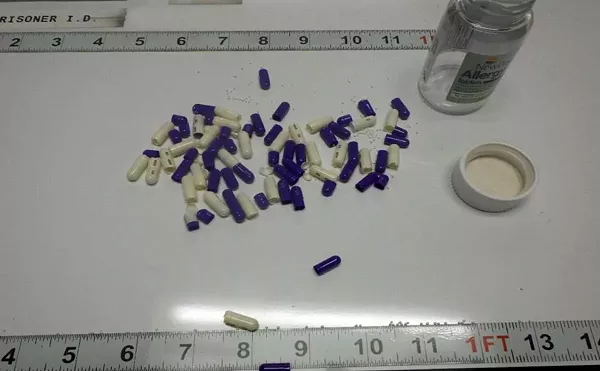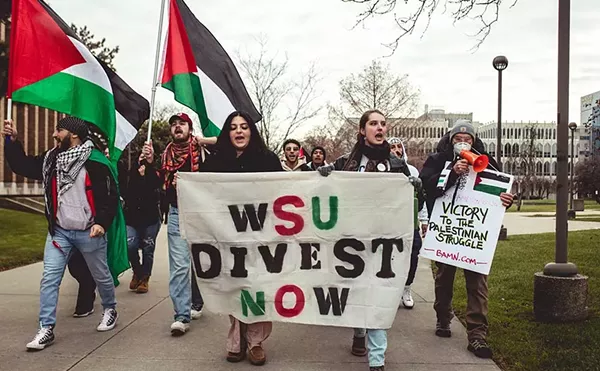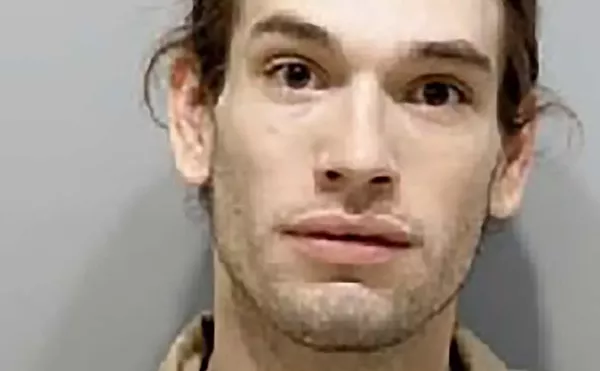The courtroom, on a former military base in the Netherlands, was full of guards armed with semiautomatic weapons. Nobody was allowed to walk around. Relatives of the victims could present photo ID, and when their name was checked on a list, they were allowed into a family room separated by a thick glass wall.
From there they could see the courtroom and the men accused of killing their loved ones.
Al Amin Khalifa Fhimah, dressed in traditional Arabic clothes, looked around and seemed a little nervous. Abdelbaset Ali Mohmed Al Megrahi, wearing a Western business suit and tie, didn't look at anyone.
"Like he was the mob godfather; he had all the confidence in the world that he is going to get off," says Sue Bennett of Ann Arbor, who was among those watching from the far side of the glass for a time last summer.
And should Megrahi and Fhimah get off? Did they kill Larry Bennett, the father of her three sons? Others in the room were also wrestling with similar questions, all stemming from one tragic day 12 years ago when Pan Am Flight 103 was blasted from the sky over Lockerbie, Scotland. That day changed hundreds and hundreds of lives.
"I do believe in accountability," Bennett says. "There has to be some kind of retribution."
And where she once thought that merely seeing the trial would bring solace, that wasn't the case.
"I thought it would give me a sense of closure, but seeing the suspects presented more questions to me than answers," she says. "Are these the two responsible? I am sure that they were involved, but the question remains: who else?"
Bomb site
Four days before Christmas 1988, Bennett was running errands and stopped briefly at a friend's house. Casually, her friend mentioned a news flash "about a plane that crashed over Scotland. It was supposed to land in Detroit at midnight."
Time stood still. "I could barely whisper: Larry is due to arrive just after midnight," Bennett recalls.
At home she found the paperwork confirming that her husband was on Flight 103. Eventually she would learn the details, including that 13 Michigan-bound passengers were on the plane. Precisely 37 minutes after takeoff from London's Heathrow Airport, Pan Am 103 was at 31,000 feet when less than a pound of plastic explosive hidden in a Toshiba tape player went off, punching a hole in the fuselage. Like a popping balloon, the pressurized airplane blew into three pieces: the wings, the main plane fuselage, and the cockpit/first-class lounge.
Pieces of the plane smashed into the small Scottish farming village of Lockerbie below.
"The whole sky lit up and the sky was actually raining fire. It was just like liquid," reported one man who watched as debris scattered over an area two-thirds the size of Rhode Island.
"Until you visit a site that has been hollowed out by a bomb, seeing the wreckage or the people whose lives have been ruined by it, I don't think you fully understand," says Bennett, talking about the first time she went to Lockerbie, one week after the crash. More trips to Lockerbie would follow, as would trips to New York, Washington, D.C., and the Hague.
The following October she flew to Lockerbie to get some of her husband’s belongings back. "They took everyone's clothes, if they weren't blown off of them, and had them deep frozen. But even frozen it smelled really bad. His things were all burned and torn. I didn't really want them. There is so much other stuff you can keep."
Mysteries
The bombing of Pan Am Flight 103 triggered what has been described as the largest murder investigation in history, and the families of the victims have had their lives tethered to its twists and turns and politics.
Two alleged members of Libyan Intelligence Service, Fhimah and Megrahi, face charges of murder and conspiracy to murder for the death of 270 people, the 259 passengers and crew plus 11 Lockerbie residents who died on the ground.
From the beginning, mysteries surrounded the crash. There were reports that intelligence agencies had received and failed to heed several warnings preceding the bombing. The presence of CIA agents and other assorted intelligence operatives on the flight raised suspicions that they were somehow the targets or otherwise linked to the blast.
For the first two years after the crash, however, officials said the evidence pointed to Syria and Iran, likely as retaliation for an incident the previous July: A U.S. warship patrolling the Persian Gulf mistakenly shot down an Iranian Airbus, killing 290 people.
The outbreak of the Gulf War changed the direction of the investigation, according to critics, including survivors of some Lockerbie victims. When Saddam Hussein's troops rolled into Kuwait, the Bush administration needed Syria as an ally, and needed Iran to at least remain neutral.
The U.S. government says it was new evidence about the detonating device that shifted the investigation focus to Libya. In 1991, Fhimah and Megrahi were charged with sending the Samsonite suitcase containing the deadly radio from Malta to Frankfurt to London to the skies over Lockerbie. The motive? Libyan leader Colonel Moammar Qaddafi allegedly wanted revenge for the l986 bombing of Tripoli and Benghazi in Libya by the United States.
Years of negotiations followed to get Qaddafi to hand over the two suspects for trial. International sanctions against Libya were put in place. Finally, in 1998, the combined efforts of UN Secretary General Kofi Annan and Nelson Mandela, along with pressure from the Arab League, prevailed. Qaddafi agreed to hand the men over for trial and accepted the proposal to try them under Scottish law but in a neutral country.
A former NATO air base in the Netherlands (Camp Zeist) was rebuilt as a high-security court for $20 million. The trial which opened there in May is expected to last for a year. It has been going badly for the prosecution, which was forced to release internal CIA cables undermining the credibility of a key Libyan witness.
Paradox
Almost immediately after the crash, families of the victims coalesced into a powerful interest group. "It is a paradox, but sometimes I think it is a blessing that it happened to so many people. So many others understand," says Bennett, who chaired the original victim's group, Victims of Pan Am 103.
The American families eventually came into conflict with one another because of different opinions as to how to pursue the truth and what to do about it. Some wanted the United States to bomb Libya; others wanted to continue pursuing Iran and Syria as likely culprits.
The families eventually separated into several groups, all calling for justice but defining it in different ways.
"There were a lot of personality clashes. Those who lost children pushed the hardest. We that were widowed, had children to raise and played more and more a lesser role in the organization. But there were a lot of people that lobbied for a trial. I am glad they have."
Bennett is among those who criticize the government for not pushing harder and sooner for a trial.
"When there is a horrendous mass murder, why should the surviving family members have to go to the government?" Bennett said. She said the victims have had to push three presidents to get to where they are today.
"Ronald Reagan was in office, but we didn't hear anything about the investigation. When George Bush became president we got a letter saying that he was sorry and would get to the bottom of it. But he didn't keep his promise," Bennett says bitterly.
And under Clinton: "We had to agree to have the trial in the Netherlands to get the two guys out of Libya. If we are a superpower, why do we have to do all these things?"
But at least there is a trial now, And Clinton also erected a memorial to the crash victims at Arlington National Cemetery. It is made from sandstone quarried at Lockerbie.
Support system
Bennett has raised her own three sons, who ranged in age from 7 to 12 at the time of the crash.
"Pan Am was a very big issue and my main concern was to let my boys grow up as healthy, productive adult men." Larry was a part of their lives, says Bennett, because she told so many stories about him. "I wanted them to know their father's character."
Larry and Sue Bennett were 21 when they met at the University Christian Fellowship at Wayne State University in Detroit; he was studying organic chemistry, she was studying nursing. They were married 15 months later.
After Larry got his master's, they joined the Peace Corps and spent two years together in a little village in Afghanistan. Back in the United States, Bennett says, they "just lived like a good Christian family."
Larry worked at the pharmaceutical company Parke-Davis (now merged into Pfizer) in Ann Arbor; they built a house in Chelsea.
"It seems all so long ago, that it is if I am telling you out of a storybook," says Bennett.
She recalls a bizarre incident. "In the summer of 1988 we went camping. While the boys were playing, they stirred up a nest of yellow jackets. I got a bite on my ring finger. It swelled up so badly that I had to go to a hospital. Unfortunately they had to cut my wedding ring off; it was if I became unmarried again. It seemed an image of what was to come, since it was the summer before Larry died."
Bennett went back to school and eventually got her master's degree in social work. She does volunteer work at the Traumatic Emergency Response Network and is planning to write a book. "I would like to write about my personal and spiritual experiences after Larry died. What God has meant to me. You could say that Jesus is my support system," Bennett said.
People have told her to get on with her life and get over it. "I don't think you get over it, you get through it. I think one of the problems is that this trial is coming almost 12 years later. Had it been sooner, everybody would have expected me to go to the trial and follow it. It is not all of my life, but it is a part of who I am now. I don't think I can close my eyes and say, well, that is the end of that."
Sue sees a lot of similarities with the John F. Kennedy assassination. "I think in both cases, 25 years from now, we will know more than we ever can imagine." It might not happen in her lifetime, but maybe in her children's lifetime, Bennett thinks they will find out who killed Larry.
What will happen after the trial?
"I will go on. For my children and for Larry's sake, because he was my husband."
But she adds: "His killers need to be named and tried and convicted. All of them."
Safia Aoude, a lawyer and freelance journalist in East Copenhagen, Denmark, maintains an extensive Web site following the Lockerbie case. Click on www.geocities.com/CapitolHill/5260/.
Nicole Bosch is a Dutch freelance writer now living in Detroit. Send comments to letters@metrotimes.com





